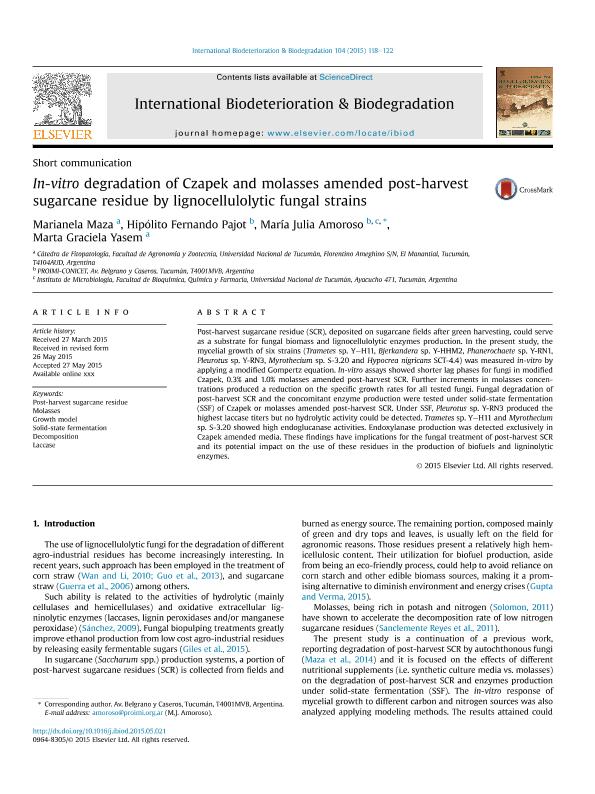Mostrar el registro sencillo del ítem
dc.contributor.author
Maza, Marianela

dc.contributor.author
Pajot, Hipolito Fernando

dc.contributor.author
Amoroso, Maria Julia del R.

dc.contributor.author
Yasem, Marta Graciela

dc.date.available
2017-12-04T14:32:13Z
dc.date.issued
2015-05
dc.identifier.citation
Maza, Marianela; Pajot, Hipolito Fernando; Amoroso, Maria Julia del R.; Yasem, Marta Graciela; In-vitro degradation of Czapek and molasses amended post-harvest sugarcane residue by lignocellulolytic fungal strains; Elsevier; International Biodeterioration and Biodegradation; 104; 5-2015; 118-122
dc.identifier.issn
0964-8305
dc.identifier.uri
http://hdl.handle.net/11336/29528
dc.description.abstract
Post-harvest sugarcane residue (SCR), deposited on sugarcane fields after green harvesting, could serveas a substrate for fungal biomass and lignocellulolytic enzymes production. In the present study, themycelial growth of six strains (Trametes sp. YeH11, Bjerkandera sp. Y-HHM2, Phanerochaete sp. Y-RN1,Pleurotus sp. Y-RN3, Myrothecium sp. S-3.20 and Hypocrea nigricans SCT-4.4) was measured in-vitro byapplying a modified Gompertz equation. In-vitro assays showed shorter lag phases for fungi in modifiedCzapek, 0.3% and 1.0% molasses amended post-harvest SCR. Further increments in molasses concentrationsproduced a reduction on the specific growth rates for all tested fungi. Fungal degradation ofpost-harvest SCR and the concomitant enzyme production were tested under solid-state fermentation(SSF) of Czapek or molasses amended post-harvest SCR. Under SSF, Pleurotus sp. Y-RN3 produced thehighest laccase titers but no hydrolytic activity could be detected. Trametes sp. YeH11 and Myrotheciumsp. S-3.20 showed high endoglucanase activities. Endoxylanase production was detected exclusively inCzapek amended media. These findings have implications for the fungal treatment of post-harvest SCRand its potential impact on the use of these residues in the production of biofuels and ligninolyticenzymes.
dc.format
application/pdf
dc.language.iso
eng
dc.publisher
Elsevier

dc.rights
info:eu-repo/semantics/openAccess
dc.rights.uri
https://creativecommons.org/licenses/by-nc-sa/2.5/ar/
dc.subject
Post-Harvest Sugarcane Residue
dc.subject
Molasses
dc.subject
Growth Model
dc.subject
Solid-State Fermentation
dc.subject
Decomposition
dc.subject
Laccase
dc.subject.classification
Otras Ciencias Biológicas

dc.subject.classification
Ciencias Biológicas

dc.subject.classification
CIENCIAS NATURALES Y EXACTAS

dc.title
In-vitro degradation of Czapek and molasses amended post-harvest sugarcane residue by lignocellulolytic fungal strains
dc.type
info:eu-repo/semantics/article
dc.type
info:ar-repo/semantics/artículo
dc.type
info:eu-repo/semantics/publishedVersion
dc.date.updated
2017-11-09T20:32:33Z
dc.journal.volume
104
dc.journal.pagination
118-122
dc.journal.pais
Países Bajos

dc.journal.ciudad
Amsterdam
dc.description.fil
Fil: Maza, Marianela. Universidad Nacional de Tucuman. Facultad de Agronomia y Zootecnia. Sanidad Vegetal. Cátedra Fitopatologia; Argentina
dc.description.fil
Fil: Pajot, Hipolito Fernando. Consejo Nacional de Investigaciones Científicas y Técnicas. Centro Científico Tecnológico Conicet - Tucuman. Planta Piloto de Procesos Industriales Microbiologicos; Argentina
dc.description.fil
Fil: Amoroso, Maria Julia del R.. Consejo Nacional de Investigaciones Científicas y Técnicas. Centro Científico Tecnológico Conicet - Tucuman. Planta Piloto de Procesos Industriales Microbiologicos; Argentina. Universidad Nacional de Tucumán. Facultad de Bioquímica, Química y Farmacia; Argentina
dc.description.fil
Fil: Yasem, Marta Graciela. Universidad Nacional de Tucuman. Facultad de Agronomia y Zootecnia. Sanidad Vegetal. Cátedra Fitopatologia; Argentina
dc.journal.title
International Biodeterioration and Biodegradation

dc.relation.alternativeid
info:eu-repo/semantics/altIdentifier/url/http://www.sciencedirect.com/science/article/pii/S0964830515300160
dc.relation.alternativeid
info:eu-repo/semantics/altIdentifier/doi/https://dx.doi.org/10.1016/j.ibiod.2015.05.021
Archivos asociados
